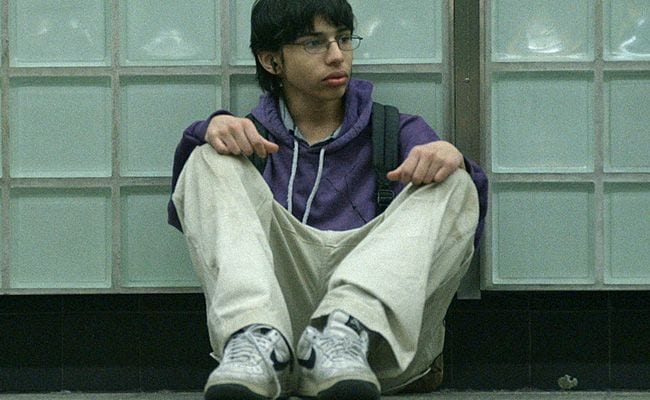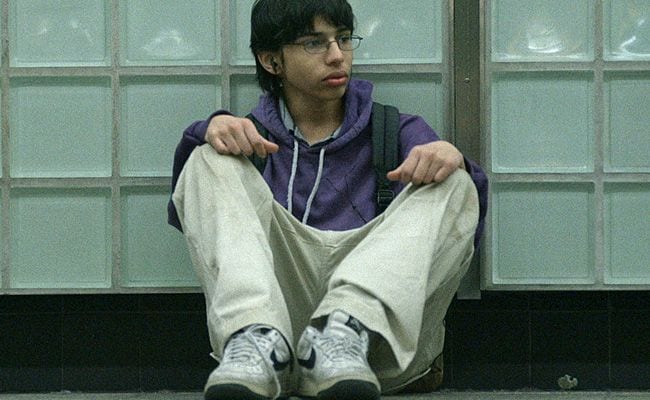
Ricky (Jesus Sanchez-Velez) holds a sneaker. The camera in Stand Clear of the Closing Doors is close on his fingers as he rubs the faux suede, vaguely purple, and the Supra crown logo. He leans in to smell the shoe, his glasses glinting in the dim light. A pop tune plays on the shop’s sound system, a speedy beat that links Ricky’s close-up with a subsequent longer shot, his sister Carla’s (Azul Zorrilla) legs, in textured tights and boots, as she waits for him, restless. “Come on Ricky,” she says, “We gotta get cat food.” Ricky remains focused on the shoe, as Carla walks into his frame, hoping to keep their disagreement between them, invisible to the boy she spots across the room, a boy trying on shoes, briefly looking her way when he hears Ricky’s voice rise.
While Carla’s nervousness, her hope not to make a scene, makes her like most other 15-year-olds, very aware of the world around her, Ricky, 13 and has Asperger’s syndrome, lives another experience, one they can’t share. If their differences seem obvious, Stand Clear of the Closing Doors goes on to consider their similarities, the sensory and emotional fragments that make anyone’s experience a mix of order and chaos.
This comparison is occasioned by a crisis, when Carla, frustrated with Ricky and also the fact that she’s expected to look after him when their undocumented domestic worker mother Mariana (Andrea Suarez Paz) is unavailable, leaves him at school and he wanders off. The movie goes on to follow what might be described as parallel tracks over the next couple of days, as Ricky rides the New York City subway and Carla, Mariana, and eventually the kids’ mostly absent father Ricardo (Tenoch Huerta Mejia), worry in their Rockaway Beach apartment, embarking each day to try to find him.
As the boy alone is surrounded by noise and movement, impressions that are alternately thrilling and frightening, weird and familiar, so too his family sees their environment and each other in new ways, the changes made vivid for you in a whirl of street and beach scenes, as well as a sonic cacophony, from construction and traffic, to the wind and surf of an approaching storm: the film is set in October 2012, when Sandy hits the Rockaways.
If the storm is an obvious bit of metaphor, the film’s other framing devices help to complicate and expand how such signs circulate. Mariana confronts a school system that absolves itself of responsibility (“What he needs is a place where the staff has training specific to autism spectrum disorder,” observes a white guy at a desk, training his budget can’t accommodate) and a police force that can’t act until the boy has been missing for 72 hours. When at last a detective (Santo Fazio) comes to her tiny apartment to ask questions and inspect the drawings of sea monsters Ricky has left behind, he’s out of breath from climbing the stairs, a point underlined when he attaches his portable oxygen tubes to his nose. “Do you want some water?” she offers. He sweats and mutters no, then proceeds to the standard questions: does Ricky have friends, places he likes to go, maybe things he likes to do?
Mariana has already asked herself these questions, and already visited the beach her son likes to walk, several times over the course of the movie. She’s encouraged to search by Carmen (Marsha Stephanie Blake), who works at the shoe store where Ricky finds sneakers he likes. “Right now your son just needs you,” Carmen tells her, “He needs you to not give up, wherever he is, he can’t find himself.”
The film uses this notion as both structure and philosophy, that no one can “find himself,” that such searches make community by definition. Ricky may not know he’s lost, as his sense of time and place can’t match his mother’s. Simultaneously, Mariana and Carla must sort out another sense of loss while also finding themselves. The film ee this not in the end of the search but in the process, on the trains where Ricky rides and the streets and shore where Mariana walks and puts up fliers. The train is rather a perfect “place” to be lost, in constant motion but also still, inside each car. During these scenes, you see what he sees, sometimes in tight frames suggesting his focus, sometimes in mobile frames suggesting his distraction. Along with the news of Sandy, you’re reminded of the US presidential election, which pops up in New York Post headlines (“Romney: The Only Choice”) and the also the annual anarchy allowed by Halloween, as Ricky looks up to see figures in chainsaw killer or dragon or Lion King costumes, their faces masked or painted, riding the subway on the way to somewhere else.
Ricky by this point is exhausted as well as lost. And so his ride on the train is ongoing and allusive as much as it might be actual, an experience that his mother cannot imagine, for which his sister cannot apologize enough, and that draws his father home from the job he’s been working “upstate.” He comes back on Halloween, when Carla’s on her way out the door in a pink Nicki MInaj wig: she stops short and embraces her dad who might, she hopes against hope, make things right. As she makes him dinner, bent over the stove in her costume, the camera watches her from the next room, where Mariana and Ricardo both sit, uncomfortably, uncertain how to speak to each other, how to make sense of the silence between them.
Here and elsewhere, Stand Clear of the Closing Doors connects experiences that look, on their surfaces, to be absolutely different. This isn’t to say that the film disrespects differences, reconciles these experiences or conjures a neat morality. Rather, it renders the many impressions that might make up these experiences, the loud smudgy blurs of trains passing, the sound of the surf crashing outside Ricky’s home, Mariana’s long walks on sidewalks and on the shore, her efforts to put up fliers and her visits to church, where she and Carla find solace in a chorus, a sound you now understand is of a piece with the city’s noise even as it might be different.


![Call for Papers: All Things Reconsidered [MUSIC] May-August 2024](https://www.popmatters.com/wp-content/uploads/2024/04/all-things-reconsidered-call-music-may-2024-720x380.jpg)



